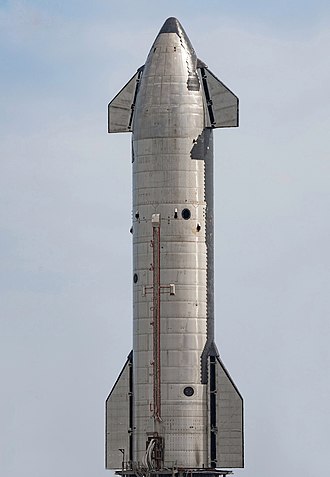
“… the booster will spend six minutes in the air overall, two upon ascent and four for its return trip. In the future, the system could be reused every six to eight hours for three launches a day. SpaceX says achieving a fully and rapidly reusable system is “key to a future in which humanity is out exploring the stars.” Musk also talked about how in-orbit refilling — not “refueling,” since the vehicle’s Raptor engines use more liquid oxygen than fuel — is essential for long-duration flights.
The Super Heavy booster, Musk said, has more than twice the thrust of a Saturn V, the largest rocket to ever head to space so far. In its current iteration, it has 29 Raptor engines, but it could eventually have 33. Speaking of those engines, Raptor version 2 is a complete redesign of the first, costs half as much and needs fewer parts. The company is capable of manufacturing five to six a week at the moment, but it could apparently be capable of producing as many as seven by next month.
Aside from being able to carry hundreds of tons, the Starship could revolutionize space travel if SpaceX can truly make launches as affordable as Musk said it could. He revealed during the event that a Starship launch could cost les than $10 million per flight, all in, within two to three years. That’s significantly less than a Falcon 9 launch that costs around $60 million.”
https://www.engadget.com/spacex-shows-starship-launch-050753751.html

I’m fairly confident that the super heavy booster will work as advertised. All the Starship tests certainly ironed out the kinks in the booster. What I’m most curious to see us how the Starship handles atmospheric reentry. It doesn’t have a conventional heat shield. Originally it was to rely on the cooling effect of fuel leaking out of small pores of a double skinned hull. That idea was abandoned in favor of a new stainless steel alloy skin. We’ll see how that works.
$10 million a flight for a payload of 100 tons/tonnes is a staggeringly low figure of just $100 per kilo into orbit. The chart below puts that figure into perspective and forecasts the $100/kg figure around 2037. It’s in inflation adjusted dollars and note the logarithmic vertical scale. The chart dates from 2018 and doesn’t feature Starship, but it looks like Musk is planning on outdoing NASA’s “long-term goal of making LEO accessible for tens of dollars per kilogram by 2040”. Go for it Elon.
https://www.futuretimeline.net/data-trends/6.htm
sic itur ad astra
Thanks…Beautiful Of The Star Ship… Reminds me of A Longer HIGH BREED…verson of the Shuttle..Look At The Nose Cabin..,,Same.. Fuselage Longer ,,Sleek..New Skin..New Rudder Controls..High Tech…Much Better Engines..More Powerfull Better Fuel Burn,,I Am A Old..(Der) Sci Fi Fan..Among Other Things..The Space Program is The One Event..That Can Capture..Our Dreams..Imagination..Sense Of ADVENTURE..
God Speed..
the big problem with Starship is the Biden admin has a block on test flights since May of last year. The FAA is taking forever to evaluate the SpaceX application for orbital launches from the highly impressive launch facility in Boca Chica, Texas. No one of prominence is speaking up publicly in defense of SpaceX. Why are Ted Cruz and the governor of Texas silent? Elon spoke the other day that he would have to move operations to Florida in the event of an FAA denial.
the booster will spend six minutes in the air overall, two upon ascent and four for its return trip. In the future, the system could be reused every six to eight hours for three launches a day.
What type of pre/post launch inspections will need to be conducted on critical components/systems before reuse?
How much time will the inspections take?